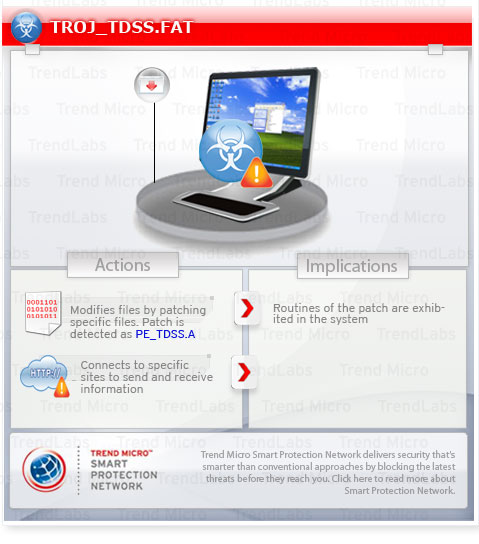TROJ_TDSS.FAT
Windows 2000, XP, Server 2003


Threat Type: Trojan
Destructiveness: No
Encrypted: Yes
In the wild: Yes
OVERVIEW
This Trojan has received attention from independent media sources and/or other security firms.
To get a one-glance comprehensive view of the behavior of this Trojan, refer to the Threat Diagram shown below.

This Trojan may be unknowingly downloaded by a user while visiting malicious websites.
It connects to certain websites to send and receive information. It deletes itself after execution.
TECHNICAL DETAILS
Arrival Details
This Trojan may be unknowingly downloaded by a user while visiting malicious websites.
It may be downloaded from the following remote sites:
- http://{BLOCKED}mentconsulting.com/tweetdeck-08302010-update.exe
Installation
This Trojan drops the following component file(s):
- \?\globalroot\{random folder}\{random folder}\config.ini - non-malicious
- \?\globalroot\{random folder}\{random folder}\tdlcmd.dll - non-malicious
- \?\globalroot\{random folder}\{random folder}\bckfg.tmp - non-malicious
It injects codes into the following process(es):
- SPOOLSV.EXE
Other Details
This Trojan connects to the following website to send and receive information:
- http://{BLOCKED}l01.com
- http://{BLOCKED}10L.com
- http://{BLOCKED}cv1.com
- http://{BLOCKED}cv1.com
- https://{BLOCKED}4cx00.cc
- https://{BLOCKED}.{BLOCKED}.226.67
- https://{BLOCKED}3.com
- https://{BLOCKED}16b0.com
- https://{BLOCKED}dden.in
- https://{BLOCKED}fda88.com
It does the following:
- Creates a copy of itself named %User Temp%\{temporary file name}.tmp
- Changes its file characteristic to DLL
- Patches a random .SYS file (detected as PE_TDSS.A) to enable it to automatically start upon system startup
(Note: %User Temp% is the current user's Temp folder, which is usually C:\Documents and Settings\{user name}\Local Settings\Temp on Windows 2000, XP, and Server 2003.)
It deletes itself after execution.
SOLUTION
Step 1
For Windows XP and Windows Server 2003 users, before doing any scans, please make sure you disable System Restore to allow full scanning of your computer.
Step 2
AUTOMATIC REMOVAL INSTRUCTIONS
To automatically remove this malware from your system, use Trend Micro's special http://www.trendmicro.com/ftp/products/pattern/spyware/fixtool/SysClean-TROJ_TDSS.SMG.zip>fixtool. Download, extract, and run the said fixtool in the same folder where your latest Trend Micro pattern file is located. For more details, refer to the fixtool's incorporated text file.
MANUAL REMOVAL INSTRUCTIONS
Step 4
Scan your computer with your Trend Micro product to delete files detected as TROJ_TDSS.FAT. If the detected files have already been cleaned, deleted, or quarantined by your Trend Micro product, no further step is required. You may opt to simply delete the quarantined files. Please check this Knowledge Base page for more information.
Did this description help? Tell us how we did.

